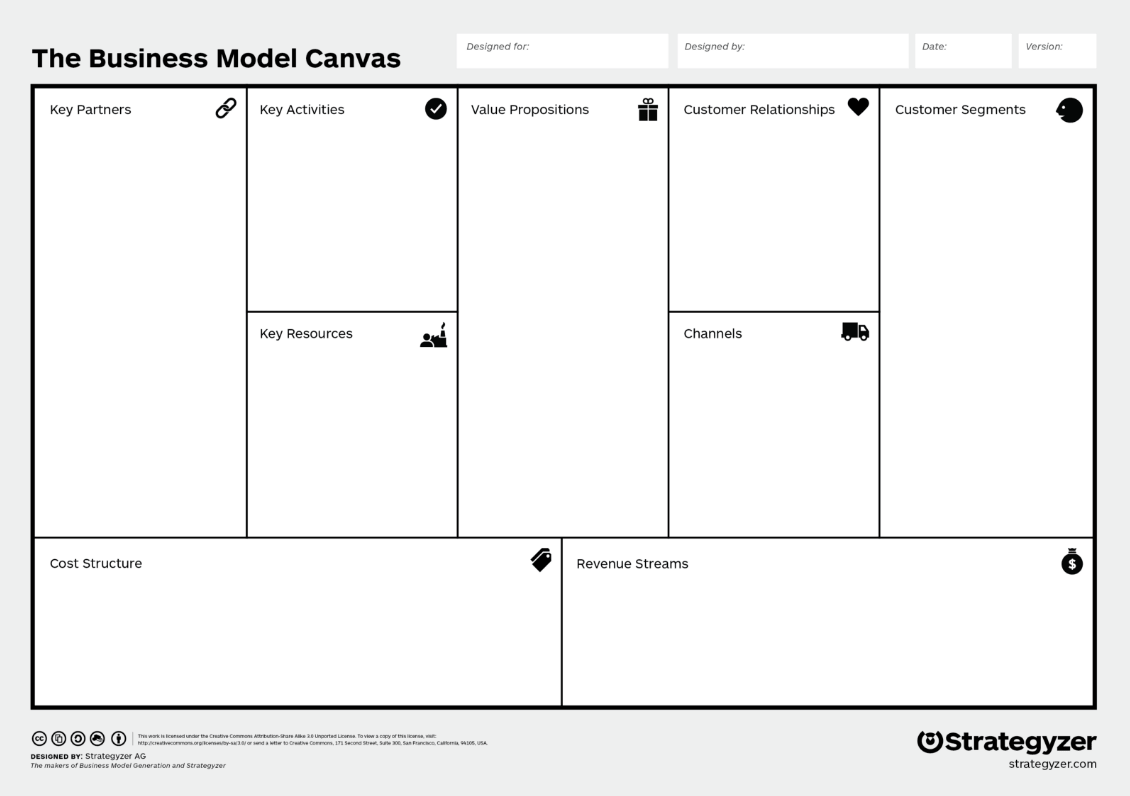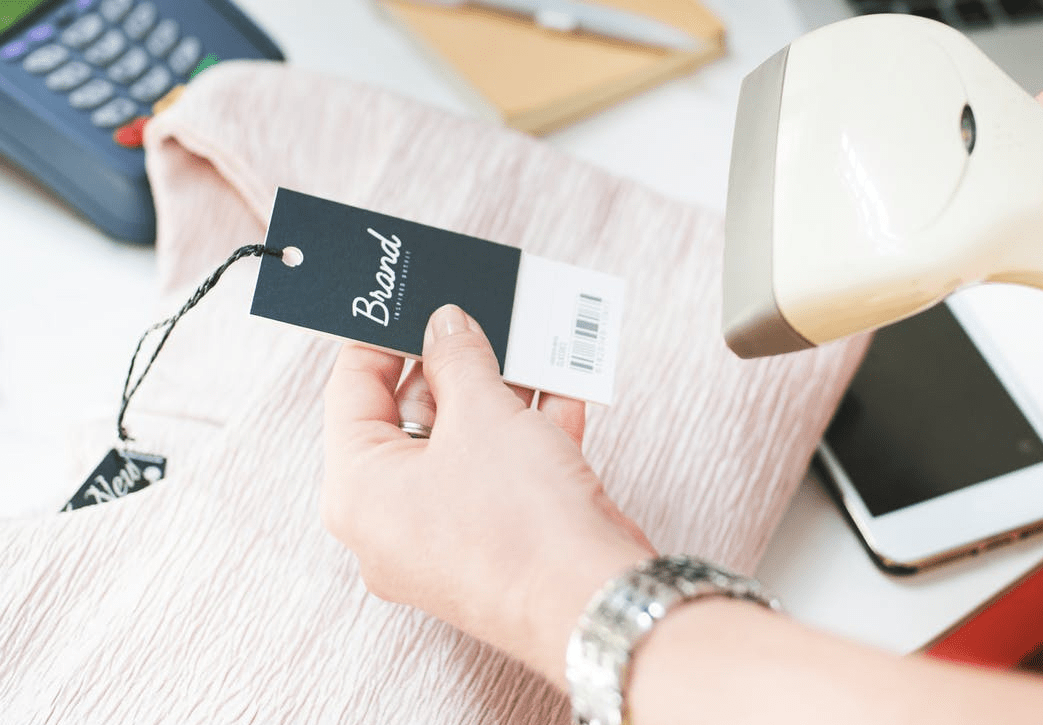How To Fill In A Business Model Canvas
(Thanks for reading, I’ve recently made an even better version of this article here)
The Business Model Canvas is a great way of mapping out an idea, allowing it to be understood, tested and improved.
The tool is a single page with nine connected boxes, which show how all parts of your business work together for success.
It can be sketched anywhere – on a whiteboard, napkin or notepad.
Filling one in can take between 15 and 30 minutes, and this guide will make the process clear and straightforward.
We’ll look at some entrepreneurs as they fill in their own canvases – it’s much easier if you get to watch somebody else.
They are:
Josh – creating a bamboo toothbrush that’s both stylish and environmentally beneficial.
Kylie and Dan – running Indigenous cultural experience programs for schools and families.
Anna – selling a range of chilli sauces that are made in Fiji.
Business Model Canvas, strategyzer.com
Step 1: Naming the purpose of the business
Without a clear purpose, how will we know if a model is good or not?
This can be whatever you like, such as:
To earn a passive income from home
To prevent the destruction of Indonesian rainforests
To improve the financial stability of our parent organisation
To provide stable livelihoods for young people at risk of being homeless
To improve the job hunting process
The great thing about this is that we now have a criteria for assessing our ideas, and have some inspiration for creative ways to reach this purpose.
Josh – “To reduce the amount of plastic that goes to landfill”
Kylie and Dan – “To preserve and celebrate Indigenous culture, and explain its relevance in our daily lives”
Anna – “To create meaningful employment in Fiji”
Step 2: Customers and Value Propositions
There’s no particular order you have to follow on a canvas, although I’ve found this to be the best place to start.
Your business is centred around your customers, the people who you believe will be motivated enough to try your new product/service in order to receive some sort of compelling benefit.
This is a real person, someone who is walking around right now.
They’re looking for solutions to their current problems, and like finding ways to make their lives easier.
Our job is to get a good understanding of this person:
What are their jobs, tasks and obligations?
What are their hopes, dreams and aspirations?
What are their core beliefs and worldviews?
Do they have a good understanding of how they might get what they want?
This is what we list in the Customer Segments box.
Firstly, we group our customers into clusters, describing each of them by their common characteristics, i.e. small business owners, students, parents, etc.
Secondly we write helpful descriptors of each customer segment.
These might be Demographics like age, race, gender, height, income or postcode.
These might be Psychographics like their political views, altruism, biases or preferences.
Keep in mind that our customers are the people who make decisions and pay for our products/services (not to be confused with the End User or the Beneficiary).
In the Value Propositions box, we describe what the customer is really looking for.
This isn’t about what we sell them, but rather why it matters.
These might be Gain Creators like increased social status, wellness, professional credibility or indulging our guilty pleasures.
These might be Pain Relievers like fear of exclusion, social shame, regaining wasted time, or reduced anxiety.
We want to understand how our products/services make their lives better, to the point that customers will happily pay us for this Value Proposition.
Josh – We have two customers:
1. Young professionals who want to buy cool, environmentally friendly gifts for themselves and their friends.
They love the aesthetics of the brushes and the story of the movement. It’s a simple way of doing something cool.
2. Mothers with young children, who want to create a mindset of environmental responsibility in their daily decisions.
They like the personalised colours of each brush, and by making teeth brushing fun they get fewer objections from their kids twice a day.
Kylie and Dan – We have two customers:
1. Schools who want workshops and incursions for their primary students.
They love how engaged the students are, and that it’s a great way to incorporate NAIDOC week each year.
2. Couples and families who want to learn more about Indigenous culture.
They love learning about the rituals, connecting with nature and with the land, and the feeling they get from having a weekend away from hollow distractions.
Anna – We have three customers:
1. Supermarkets who stock our sauce.
They love interesting products with good margins and high turnover.
2. Cafes and burger shops.
They love having interesting brands of sauce that engage their customers, and hot sauces that are spicy without sacrificing flavour.
3. Home cooks, people who like chilli sauce.
They love the brand and its cheeky packaging, and the unique heat/flavour of the sauce.
Step 3: Channels and Customer Relationships
Now that we have a clear picture of who we’re serving and how we’ll delight them, we get to design three things: how we acquire them, how we keep them, and how we interact with them.
The Channels box is our chance to explain how we first encounter our customers, as well as how we deliver our Value Proposition.
For example, your business might find customers through Google Ads or Facebook, then serve customers through face-to-face workshops or drop-shipped packages.
We list both of these methods here.
The Customer Relationships box outlines how our interactions will unfold.
Are we hoping for a long term relationship, or a short term relationship?
Does each customer need to speak to a person, or use technology?
If so, does it need to be a particular person, or the same one each time they come back?
Will we need to work harder to acquire our customers or to retain our customers?
Does one tend to happen more naturally than the other?
These two boxes tend to pair neatly together.
By understanding our customer, their desires and their preferences, we can identify the best methods for recruiting and keeping them for years to come.
Josh – Our acquisition channels are Instagram and word of mouth, whereas our main delivery channel is through mail orders.
Our customers are tough to acquire but are then quite loyal, and our transactions are highly automated.
Once we find a way to tell the story and show them how great the product looks, it’s easy to get an order.
Kylie and Dan – Personal referrals are our best acquisition channel, but we’re keen to find new ways of reaching decision makers within primary schools, who usually make decisions six months in advance.
Our online presence will need to improve, and we’re about to start testing keywords.
Most of our customers come back each year, so our focus is on acquiring new customers, especially in off-peak times.
Anna – Supermarkets and cafes need an in-person pitch meeting, to hear the story and see the product for themselves.
We have a hard time with retention, so there needs to be a long term personal relationship with each manager.
Our direct customers come through our online channels, but tend to only order once.
Step 4: Key Resources, Key Activities and Key Partners
These three boxes describe how the business will work “behind the scenes” – all of the operational components that make the Value Propositions a reality.
We want to list all of the vital ingredients, important processes and invaluable allies that enable our business to exist.
Key Resources are the people, places, machines, patents and intangible assets that are used every week.
This is not a complete inventory, but a list of the resources that, if lost, would prevent the business from functioning.
Key Activities are the processes and tasks that must be completed in order for our customers to be served.
e.g. If you were to go on Holiday, what would your replacement need to do in order for things to continue to run smoothly?
These might include sales calls, workshop delivery, meal preparation or writing reports.
In particular, these are the activities that you do particularly well.
Since every business does a little bookkeeping, that’s probably not your Key Activity…unless you’re an accounting firm.
Key Partners are the people and organisations that take some of the responsibility off your shoulders.
They might supply raw materials or finished goods, send customers your way, or act as a sponsor/enabler.
Which external supporters are essential to the model?
Who could make life difficult if they were to leave?
There’s some flexibility in these three boxes, it’s worth thinking about how you could outsource the tasks that aren’t your core skills to a partner, or how you could take things in-house to either save money or improve quality.
Josh – Most resources and activities have been better performed by partners, who grow the bamboo and manufacture the brushes.
The essential resources are the brand, website, sales channels and the founder.
The essential activities are advertising, fulfilling orders and meeting with stockists.
Kylie and Dan – The most essential resources are Kylie and Dan, as their knowledge and credibility are what make the entire operation possible.
The essential activities are the promotion and sales of their events.
They are currently looking for partners who can take the administration functions away from the founders, and who can introduce them to new schools.
Anna – Chilli farming and sauce manufacturing are performed by partners.
The essential resources are the brand, the recipe/intellectual property, and the sales team.
The essential activities are pitching to new supermarkets and cafes, maintaining existing relationships, and fulfilling the orders that come through the website.
Step 5: Cost Structure and Revenue Streams
The bottom line of the canvas represents the bottom line of your business:
Money in, money out, hopefully some money left over.
We want to understand the ways in which money moves through the business.
That means understanding the quantities (how our costs/prices are set) and frequencies (how often we get repeat customers/bills).
Cost Structures are the 7-8 biggest expenses – how much we spend, how frequently we spend it, and whether it changes as sales go up and down.
These might include rent, wages, raw materials, advertising, fitting out the store, or paying commissions to other parties.
Revenue Streams are the prices each type of customer typically pays, as well as how frequently they come back.
This helps us differentiate the big spenders from the one time shoppers, and highlights which offerings are purchased upfront versus those that are purchased over the following months and years.
Whilst these boxes aren’t a replacement for a proper financial model, they at least give us the ability to make basic forecasts, such as contribution margins and breakeven points.
It also gives us a chance to think about our pricing strategy – clever pricing can massively increase the profitability of your new business.
Josh – The main costs within the business are the purchase of brushes (recurring costs that will decrease as the orders get larger), the cost of acquiring customers (ads and content creation) and the costs of fulfilling orders (packaging, postage and staff time).
Revenue comes through one main product; 4-packs of brushes.
This will need to be diversified, either through complementary offerings like floss or mouthwash, selling larger orders to different customers, or selling individual brushes.
Kylie and Dan – Kylie and Dan themselves are the main costs, with administration, travel and cost of sales (ticketing, materials, etc) the next largest.
Revenues are varied; schools pay a per-student rate of $15 that will increase in the future.
Weekend camps are capped at 18 places at $375 each, so the amount of revenue comes down to the number of camps run each year.
Anna – There are a long list of costs, from the bottles to the sauce to the shipping and labelling, as well as the administration and sales staff wages.
Revenues all stem from the same product – 450ml bottles of sauce, but in different quantities and prices points.
Supermarkets pay $6 per bottle, whereas cafes pay $8 and consumers pay the RRP of $12.95.
That said, one supermarket buy more sauce than ten cafes.
Step 6: Linking The Boxes +Tidying Up
Our boxes aren’t nine independent checklists, that wouldn’t help your idea.
Instead the canvas keeps our ideas accountable; if we make a promise somewhere on the right, it will also need to be listed in one of the boxes on the left.
If we make claims about our happy customers, that should shine through in our Revenue Streams.
If we expect to keep personal relationships with each customer, that will become a part of our Key Activities and Cost Structure.
This does two things: highlights the potentially overlooked activities and resources that are crucial for success, and makes us reconsider the expenses that don’t directly contribute to the Value Proposition.
Long story short, you stop making big sweeping assumptions and waste less money.
We want the canvas to be as clear as possible, both for our benefit and for explaining the idea to other people.
One way of making sense of the right hand side is to colour code each customer segment; this highlights which value proposition best delights each customer, and which revenue streams they each provide.
Step 7: Telling The Story
Presenting a full canvas to a new person is not a good idea – there’s too much to take in.
Instead, it’s best to fill in each box as you explain the idea.
This makes the business much easier to understand, and creates a much richer appreciation of the model at the end.
Even if you just list a few words in each box, this will take about 6-8 minutes to explain the full concept, and will remove a lot of misconceptions.
Step 8: Assumptions Testing
Just because you wrote something clever on a canvas doesn’t make it a reality.
For this reason, we start by assuming that all of the words on the page are assumptions, and our next job is to verify them – starting with the most crucial.
I find this is made easier with a simple Test Card, which asks you to name the big assumptions, pick a way of measuring the truth, and setting pass/fail criteria.
Research should be conducted with real people, and they need to be people who are in your customer segments.
Just because your friends think it’s a cool idea doesn’t mean that the market will too.
When you talk with your customers, don’t show them the canvas – it’s better to ask natural questions that help you fill in each box, rather than using all of the same terminology.
Step 9: Designing New Versions
Good ideas survive competition, so it’s important that we don’t fall in love with the first idea.
After your testing, you’ll start thinking up new adjustments that are worth exploring.
Here are some suggestions to spark your creativity:
· New Customer Segments
· New Value Propositions (for the same Customer Segments)
· New Products/Services (for the same or new Customer Segments)
· Turning Services into Products
· Turning Products into Services
· New Partnerships
· Franchise models (that aren’t reliant on a rare resource)
· New delivery formats
Josh wants to test some new products with his current customers, whilst also looking at business class airlines and high end hotels, as they both want to provide toothbrushes to their customers whilst appearing environmentally responsible.
Kylie and Dan are going to test new styles of workshop that appeal to their school groups at different times of the year.
They also want to bring on some trainees to learn how to run camps and workshops, so that the model is not as dependent on the two of them (which is a risk to their finances and their cultural intent).
Anna has heard that her supermarket customers want to see a wider range of products, so she’s going to test feasibility with her manufacturing partners and desirability with her customers.
What’s Next?
Now that you have 3-4 interesting Business Model Canvases, some additional tools will make the future even clearer.
Customer Journey Mapping will give you insights into how you can better attract/serve/retain your customers.
Financial Models will reveal what makes the business financially viable, and highlight the sensitivities that will make or break the idea.
Value Proposition Canvases will dive deeper into your customers and their hidden motivations, creating more persuasive messages that will lure them in.















